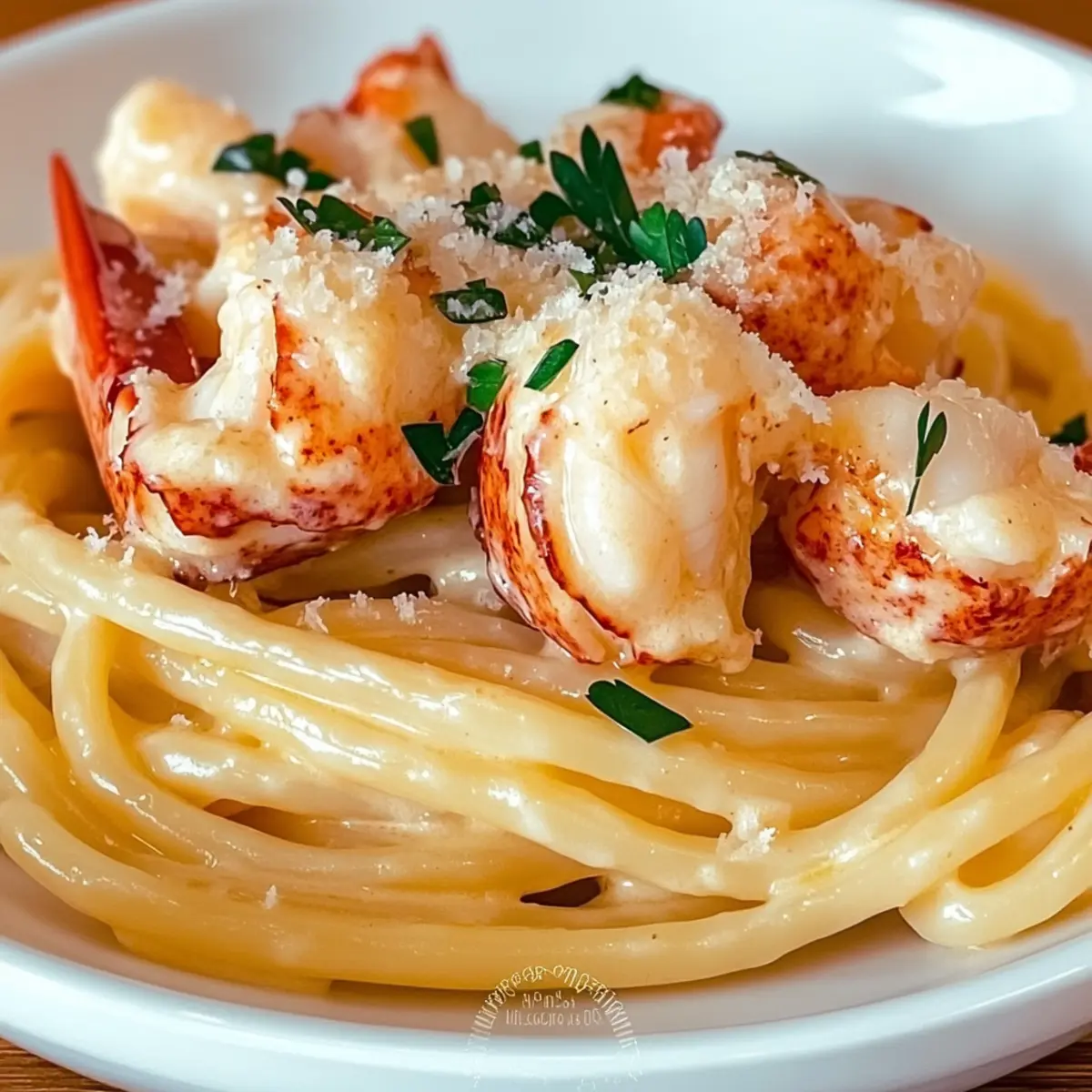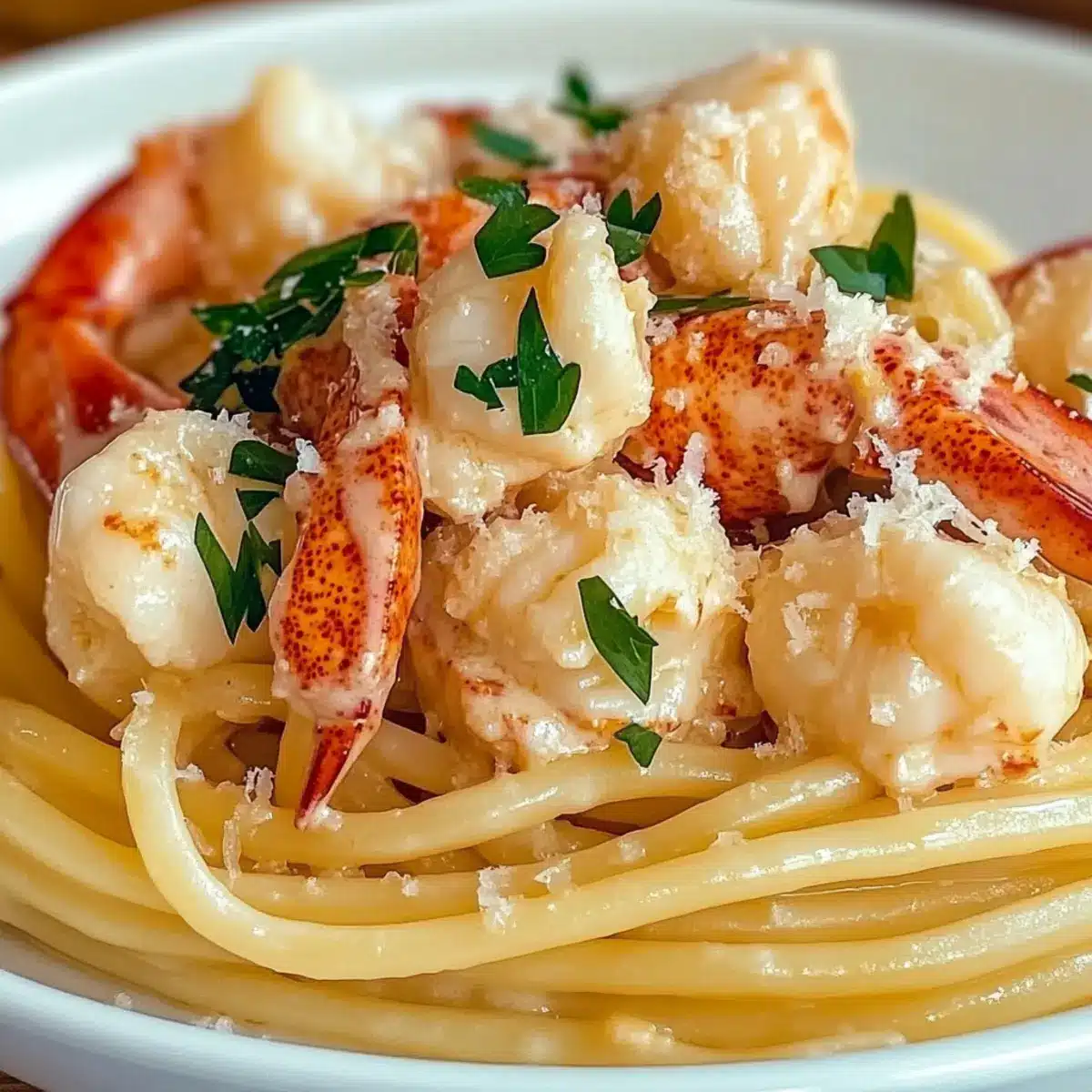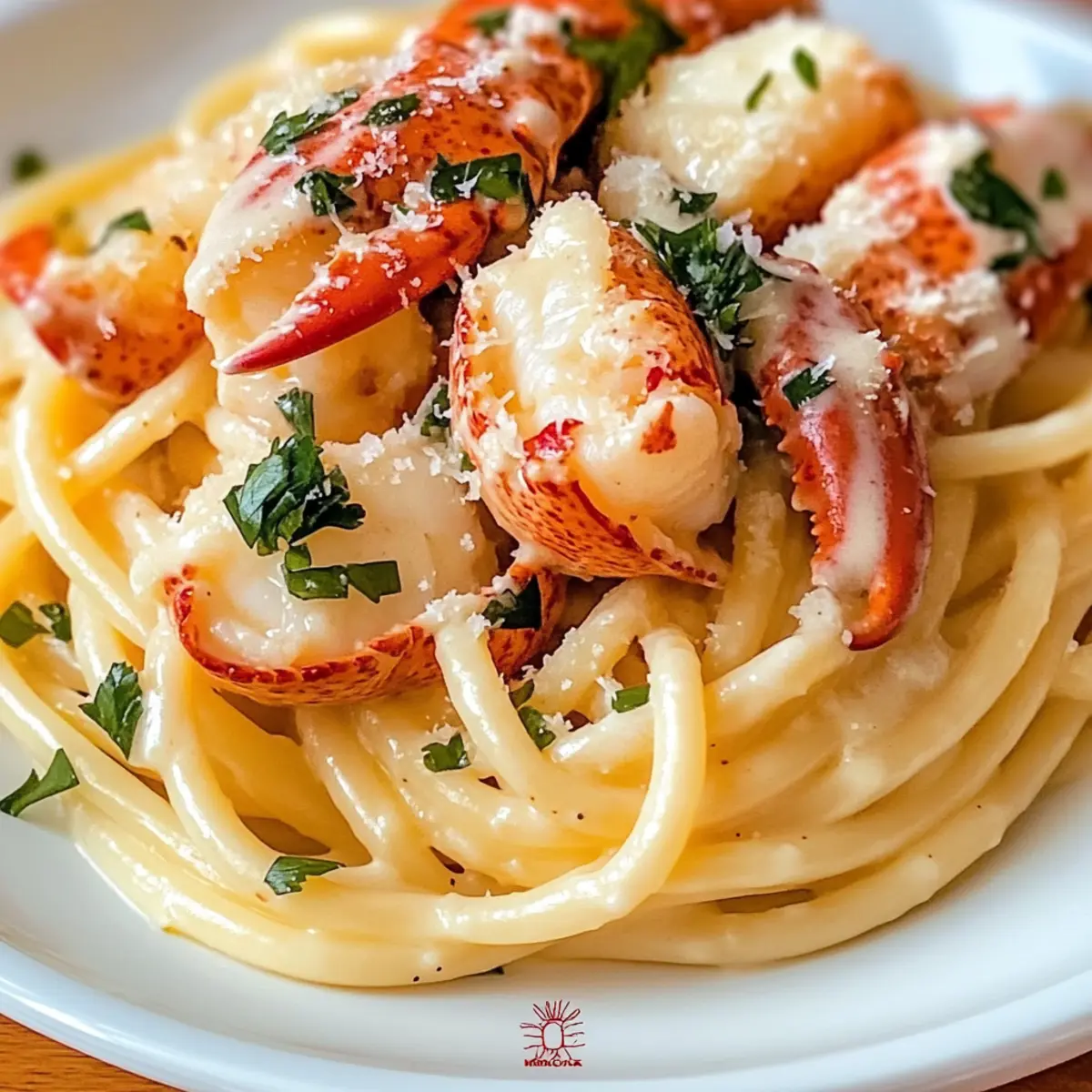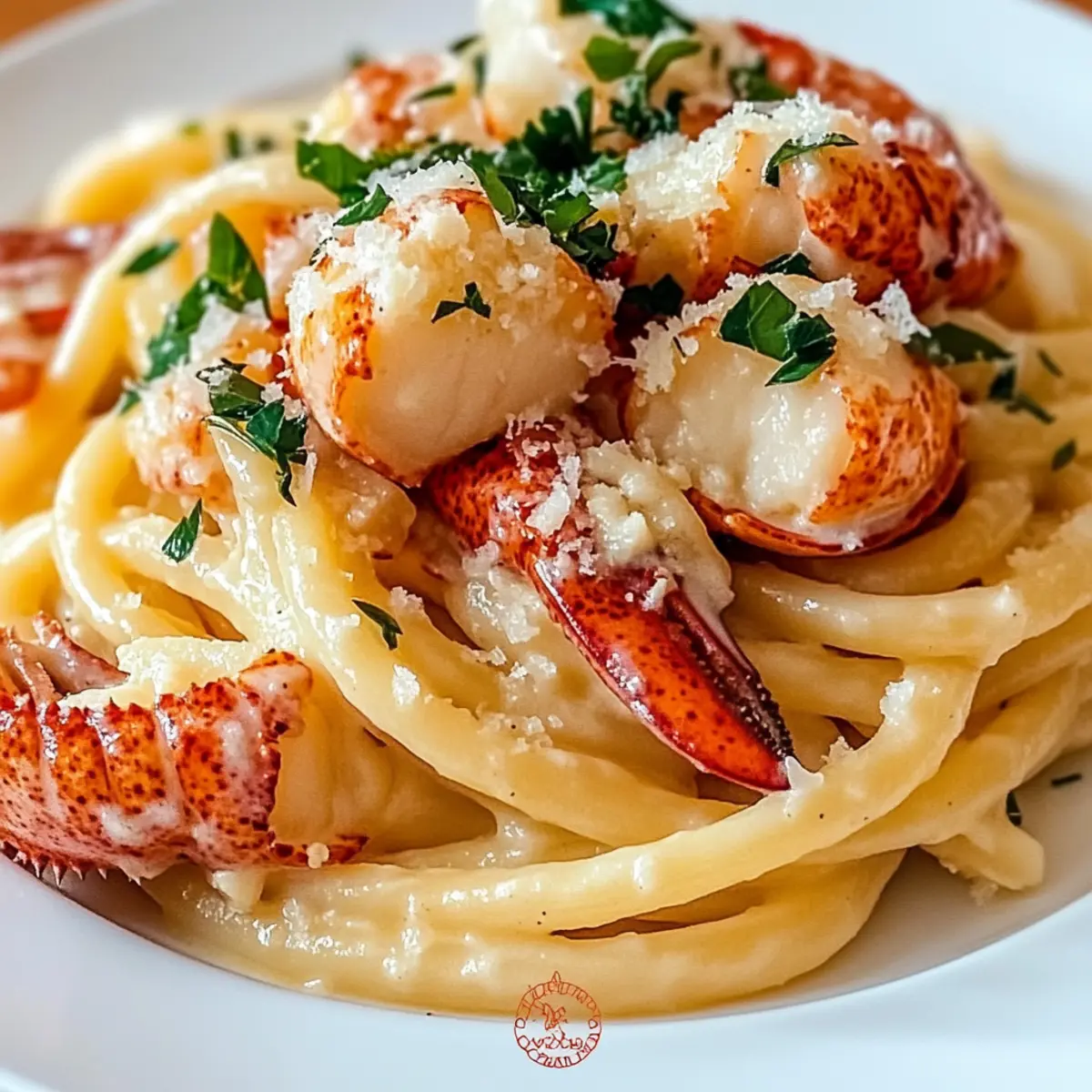As the sun dips below the horizon, filling the kitchen with a warm golden glow, I’m often whisked away into a world of culinary delight. Today, I’m thrilled to share my recipe for Lobster Bucatini, a luxurious seafood pasta that transforms an ordinary evening into an extraordinary experience. This dish brings together tender pieces of succulent lobster and a silky garlic-butter sauce, ensuring you’ll impress your family or guests with its restaurant-quality flair. Plus, it’s surprisingly simple to make, so you won’t spend hours in the kitchen! Whether you’re celebrating a special occasion or simply treating yourself to a delicious meal, this Lobster Bucatini is bound to satisfy your cravings. Ready to elevate your dinner routine? Let’s dive into what makes this dish so irresistible!

Why is Lobster Bucatini a Must-Try?
Indulgence Awaits: This Lobster Bucatini is a true celebration of flavor, combining tender lobster meat with a luscious garlic-butter sauce.
Simple Elegance: With just a handful of ingredients, you can create a gourmet dish without the fuss, making it perfect for home cooks at any skill level.
Crowd-Pleasing Delight: This seafood pasta dish tantalizes taste buds, making it an excellent choice for impressing guests or enjoying a cozy night in.
Versatile Options: Whether you stick to classic lobster or switch things up with shrimp, the variations are endless.
Restaurant Quality: Experience fine dining at home with this luxurious recipe, ideal for special occasions or any day that deserves a treat.
Lobster Bucatini Ingredients
-
For the Pasta
• Bucatini Pasta – Provides a hearty base; its hollow center captures the sauce. Substitution: Linguine or spaghetti can be used. -
For the Sauce
• Cooked Lobster Meat – Adds sweetness and a rich, tender texture. Prep Note: Ensure lobster is thawed and patted dry to avoid excess water in the sauce.
• Unsalted Butter – Richness and flavor base for the sauce. Substitution: Use additional olive oil for a dairy-free option.
• Olive Oil – Enhances flavor and helps sauté garlic. Essential for a well-balanced fat content in the sauce.
• Garlic – Provides aromatic depth, a key flavor component. Use fresh minced garlic for the best taste.
• Red Pepper Flakes – Optional heat that complements the dish. Leave out if you prefer a milder flavor.
• Dry White Wine – Adds acidity and complexity to the sauce. Recommended: Sauvignon Blanc, Pinot Grigio, or Chardonnay.
• Reserved Pasta Water – Helps achieve a silky sauce consistency. Be sure to reserve before draining pasta.
• Salt and Pepper – Essential seasonings to enhance flavor. Adjust to taste. -
For the Garnish
• Fresh Parsley – Brightens the dish with color and freshness. Finely chopped for best incorporation.
• Parmesan Cheese – Adds savory depth and richness. Substitution: Pecorino Romano or Grana Padano work equally well.
Step‑by‑Step Instructions for Lobster Bucatini
Step 1: Cook the Bucatini
Bring a large pot of salted water to a rolling boil, then add the bucatini pasta. Cook for about 9–11 minutes, or until it reaches al dente texture, ensuring it retains a slight bite. Just before draining, reserve ½ cup of the starchy pasta water for later use. Drain the pasta and set it aside, keeping it warm while you prepare the sauce.
Step 2: Prepare the Sauce Base
In a large skillet, melt 2 tablespoons of unsalted butter and 1 tablespoon of olive oil over medium heat. Allow the butter to foam and slightly brown, which should take about 2 minutes. This rich aroma will signal that you’re on the right track for your Lobster Bucatini’s creamy sauce base, perfecting that savory richness.
Step 3: Sauté the Aromatics
Add 4 minced garlic cloves to the skillet and sprinkle in a pinch of red pepper flakes if desired. Sauté the mixture for about 1 minute until the garlic becomes fragrant and golden, being careful not to let it burn. This step infuses the oil with delicious garlic essence, essential for your sauce.
Step 4: Deglaze with Wine
Pour in ½ cup of dry white wine and increase the heat slightly. Allow the mixture to simmer for 2–3 minutes, or until it reduces by half, thickening the sauce slightly. The wine will add depth to the Lobster Bucatini while enhancing the garlic-butter flavor.
Step 5: Add the Lobster Meat
Gently fold in 1 cup of cooked lobster meat into the sauce, ensuring it’s evenly distributed without breaking apart the tender pieces. Stir gently for about 1–2 minutes until the lobster is heated through, allowing the flavors to meld. This step is crucial for preserving the richness of the lobster, making your dish luxuriously satisfying.
Step 6: Combine Pasta and Sauce
Carefully add the drained bucatini pasta to the skillet, using tongs to toss it with the lobster and sauce. Gradually mix in some of the reserved pasta water, about ¼ cup at a time, until you achieve a silky consistency that clings to the pasta beautifully. This is where the Lobster Bucatini comes together, creating a harmony of flavors.
Step 7: Final Seasoning and Garnish
Season your dish with salt and freshly cracked black pepper to taste, stirring well to combine. Remove the skillet from the heat and fold in a handful of finely chopped fresh parsley for color and freshness. This finishing touch brightens the flavors, elevating your Lobster Bucatini to perfection.
Step 8: Serve with Elegance
Plate the Lobster Bucatini in generous portions, garnishing each serving with shaved Parmesan. Serve immediately, allowing the warmth of the dish to entice your guests with its fragrant aroma. Enjoy the luxurious textures and flavors of your homemade Lobster Bucatini, reminiscent of a fine dining experience right at home.

Lobster Bucatini Variations & Substitutions
Customize your Lobster Bucatini with these tasty twists; they’ll take your dish to the next level!
-
Seafood Swap: Substitute lobster with shrimp or crab for a different but equally delicious seafood flavor.
-
Veggie Boost: Add sautéed vegetables like spinach or cherry tomatoes for extra color and nutrition. The freshness complements the richness of the sauce beautifully.
-
Gluten-Free Option: Replace traditional bucatini with gluten-free noodles to accommodate dietary needs without sacrificing taste.
-
Herb Infusion: Incorporate fresh basil or dill instead of parsley for a unique herbal twist that adds a fragrant touch.
-
Creamy Texture: For extra indulgence, stir in a splash of heavy cream to the sauce for a luxurious, velvety texture that enhances the flavor.
-
Spicy Kick: Increase the heat level by adding more red pepper flakes or even a dash of hot sauce for those who love a fiery finish.
-
Citrus Zest: Add a squeeze of lemon juice and some zest to brighten the flavors, cutting through the richness while adding a refreshing note.
Feel free to explore these variations and tailor this dish to your palate. If you ever fancy a different kind of pasta, check out my recipe for Linguine with Clams or consider using Shrimp Scampi for a delightful seafood alternative!
Storage Tips for Lobster Bucatini
Fridge: Store leftover Lobster Bucatini in an airtight container for up to 2 days. Make sure it cools completely before sealing to prevent condensation.
Freezer: If freezing, transfer into a freezer-safe container or resealable bag for up to 1 month. Note that the pasta may become softer upon reheating, affecting its texture.
Reheating: Gently reheat in a skillet over low heat, adding a splash of broth or reserved pasta water to maintain moisture and creaminess. Avoid microwaving, as it can overcook the lobster.
Enjoy Promptly: For the best taste and texture, enjoy your Lobster Bucatini fresh. The flavors meld beautifully when served immediately!
Make Ahead Options
Prepare your Lobster Bucatini ahead of time to save valuable kitchen minutes on busy weeknights! You can cook the bucatini pasta and refrigerate it for up to 3 days. Additionally, you can make the garlic-butter sauce (minus the lobster) and keep it in an airtight container in the fridge for up to 2 days. To maintain quality, store the lobster meat separately and fold it in just before serving; this prevents it from becoming overcooked or tough. When you’re ready to enjoy, simply reheat the sauce in a skillet, add the lobster to warm it through, then combine with the pasta for a delightful dinner that feels luxurious with minimal effort!
What to Serve with Luxurious Lobster Bucatini?
Elevate your dining experience with delightful sides and pairings that bring out the best in this elegant dish.
-
Garlic Bread: The perfect companion, this toasted delight soaks up the delectable sauce, adding crunchy texture and bold flavor.
-
Mixed Greens Salad: A fresh salad with peppery arugula, cherry tomatoes, and a zesty vinaigrette balances the richness of the pasta beautifully.
-
Roasted Asparagus: Simply seasoned and roasted, the bright, earthy taste of asparagus complements the seafood and adds vibrant color to your table.
-
Crisp White Wine: A chilled glass of Sauvignon Blanc or Pinot Grigio enhances the flavors of the lobster while refreshing your palate between bites.
-
Lemon Sorbet: End on a light note with this refreshing dessert, cleansing your palate and leaving you with a burst of citrusy brightness after the savory pasta.
-
Stuffed Mushrooms: Savory mushroom caps filled with herb cream cheese provide an earthy contrast, making for a delightful appetizer to begin your meal.
Expert Tips for Lobster Bucatini
- Fresh is Best: Use freshly cooked lobster meat for optimal flavor; frozen can work, but make sure it’s thawed and patted dry to avoid excess moisture in the sauce.
- Watch the Heat: Avoid overcooking the garlic; sauté just until fragrant to prevent bitterness, which could overshadow the lovely notes of the Lobster Bucatini.
- Silken Sauce: Gradually add reserved pasta water while mixing to achieve the perfect silky sauce consistency. Too much at once can make it watery!
- Toss Gently: Handle the lobster delicately when mixing with the pasta; this preserves the succulent pieces intact for a beautiful presentation.
- Finish Right: Stir in a little extra butter just before serving for an indulgent finish that enhances the richness of your Lobster Bucatini.

Lobster Bucatini Recipe FAQs
What type of lobster should I use for this recipe?
I highly recommend using freshly cooked lobster meat for the best flavor, but if you use frozen, ensure it is fully thawed and patted dry to avoid excess water in your sauce. Look for lobster with a sweet, ocean-fresh scent and bright red shells—this indicates high quality!
How should I store leftover Lobster Bucatini?
Store any leftover Lobster Bucatini in an airtight container in the refrigerator for up to 2 days. Allow it to cool completely before sealing to prevent condensation that can make the pasta mushy.
Can I freeze Lobster Bucatini?
Absolutely! You can freeze Lobster Bucatini for up to 1 month. To do so, transfer it to a freezer-safe container or resealable bag. Keep in mind that the texture might change after freezing and reheating, so it’s best enjoyed fresh.
What can I do if my sauce turns out too watery?
If your sauce is too watery, try adding more reserved pasta water gradually—this helps thicken it without sacrificing flavor. You can also let it simmer for a few extra minutes to allow some liquid to evaporate. Additionally, incorporating a touch of cornstarch mixed with water can help thicken the sauce.
Are there any dietary considerations for this recipe?
Certainly! For those with dairy allergies, you can substitute the unsalted butter with additional olive oil or a dairy-free butter alternative. If you have a shellfish allergy, I often recommend making this dish with shrimp or crab instead, which still gives you that delightful seafood experience!
How can I ensure my pasta is perfectly al dente?
To achieve that perfect al dente texture, cook the bucatini in boiling salted water for about 9 to 11 minutes. Be sure to taste for doneness a minute or two before the suggested time, as cooking times may vary depending on your stovetop and pasta brand! Always save that reserved pasta water as a secret weapon to finish your dish beautifully.

Decadent Lobster Bucatini for a Taste of Gourmet Bliss
Ingredients
Equipment
Method
- Bring a large pot of salted water to a rolling boil, then add the bucatini pasta. Cook for about 9–11 minutes, or until it reaches al dente texture. Reserve ½ cup of pasta water before draining.
- In a large skillet, melt 2 tablespoons of unsalted butter and 1 tablespoon of olive oil over medium heat.
- Add 4 minced garlic cloves and a pinch of red pepper flakes. Sauté for about 1 minute until the garlic becomes fragrant.
- Pour in ½ cup of dry white wine and simmer for 2–3 minutes, or until it reduces by half.
- Gently fold in 1 cup of cooked lobster meat into the sauce, stirring gently for about 1–2 minutes.
- Carefully add the drained bucatini pasta to the skillet, using tongs to toss it with the lobster and sauce.
- Season with salt and freshly cracked black pepper to taste, then fold in a handful of finely chopped fresh parsley.
- Plate the Lobster Bucatini, garnishing with shaved Parmesan, and serve immediately.

Leave a Reply